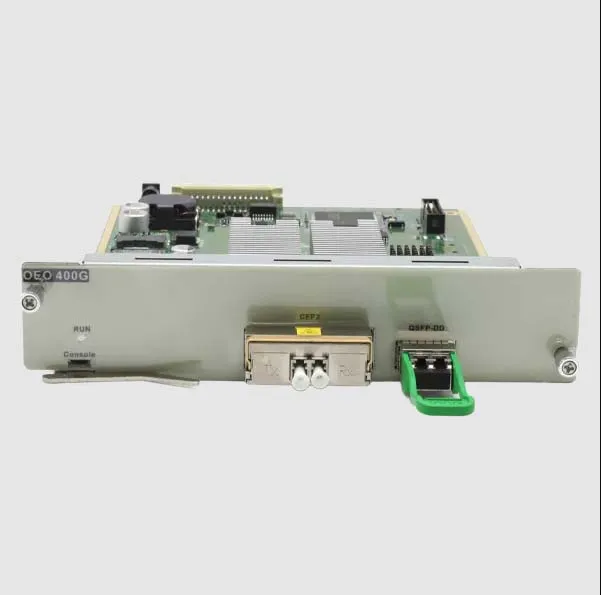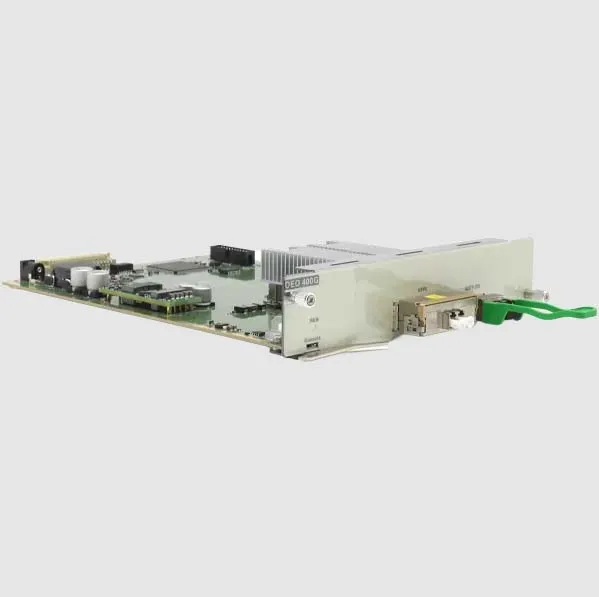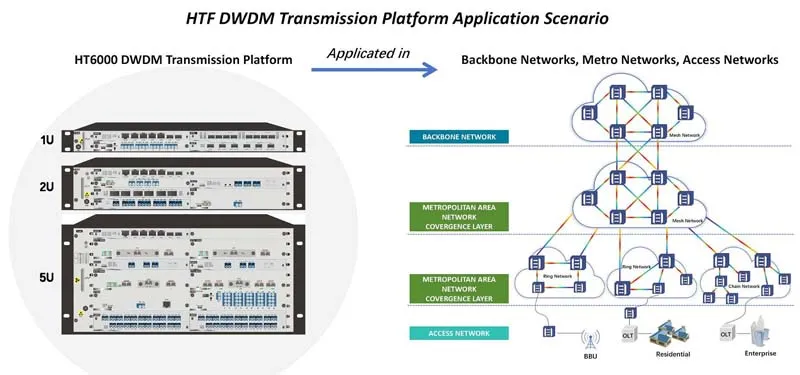In today’s hyper-connected world, the backbone of global communication lies in optical networks, which transmit vast amounts of data at the speed of light. From streaming services to cloud computing and 5G connectivity, these networks power our digital lives.
At the heart of this infrastructure are advanced devices like Optical-Electrical-Optical (OEO) converters, which ensure data travels reliably across long distances and complex systems. Among the leaders in this field is HTF, a global pioneer in optical communication solutions, renowned for its innovative products like the HTF 1.25G-10G OEO converter.
This intelligent transponder is designed to enhance Coarse Wavelength Division Multiplexing (CWDM) and Dense Wavelength Division Multiplexing (DWDM) networks, two technologies that maximize the capacity of optical fibers.
By converting signals and leveraging 3R functionality (re-amplification, re-shaping, and re-timing), HTF’s OEO converter ensures high-quality data transmission, even over vast distances. Paired with the HT6000, a compact and cost-effective Optical Transport Network (OTN) platform, this technology is revolutionizing network efficiency for Internet Data Centers (IDCs), Internet Service Providers (ISPs), and telecom operators worldwide.
This article explores how HTF’s 1.25G-10G OEO converter drives efficient CWDM/DWDM network transmission, delving into its technology, applications, and the expertise behind HTF’s global leadership. Whether you’re an IT professional or a business leader, understanding this technology can help you navigate the future of high-capacity networks.
Understanding OEO Converters and CWDM/DWDM Networks
To appreciate the value of HTF’s OEO converter, let’s start with the basics. An OEO converter is a device that transforms optical signals into electrical signals and back into optical signals.
This process allows the device to process, enhance, or redirect data as it travels through a network. Think of it as a translator who not only repeats a message but also clarifies and amplifies it for better understanding.
CWDM and DWDM are advanced technologies that allow multiple data streams to travel simultaneously over a single optical fiber, much like cars traveling in separate lanes on a highway. CWDM uses wider wavelength spacing, making it cost-effective for shorter distances, while DWDM uses narrower spacing to pack more channels into the same fiber, ideal for long-haul, high-capacity networks.
Both are critical for meeting the growing demand for bandwidth in applications like 5G, cloud computing, and data centers.
The HTF 1.25G-10G OEO converter acts as an intelligent transponder, seamlessly integrating with CWDM and DWDM systems. It converts transparent data channels into specific wavelengths, ensuring compatibility and efficiency. Designed as an SFP+ module, it’s compatible with HTF’s HT6000 series chassis (CH04, CH08, CH20), offering flexibility for various network configurations. By supporting data rates from 1.25G to 10G, this transponder caters to a wide range of network demands, from metro networks to national backbones.
What sets this device apart is its ability to process signals intelligently. Unlike simple repeaters that only boost signals, the HTF OEO converter enhances signal quality through its 3R functionality, making it a versatile tool for modern optical networks.
The Power of 3R Functionality
The 3R functionality—re-amplification, re-shaping, and re-timing—is the secret sauce behind the HTF 1.25G-10G OEO converter’s performance. Let’s break it down with an analogy: imagine a faint, garbled voice message traveling through a noisy environment. To make it clear, you’d need to amplify the volume, clean up distortions, and ensure the words are timed correctly. That’s exactly what 3R does for optical signals.
Re-amplification: Over long distances, optical signals weaken due to fiber attenuation. Re-amplification boosts the signal’s strength, ensuring it reaches its destination without loss. This is like turning up the volume on a speaker to make the sound carry further.
Re-shaping: Signals can become distorted as they travel, much like a blurry image. Re-shaping restores the signal’s original form, reducing errors and improving reliability.
Re-timing: In high-speed networks, precise timing is critical to prevent data from arriving out of sync. Re-timing ensures the signal’s pulses are perfectly aligned, like a metronome keeping a band in rhythm.
By performing these functions, the HTF OEO converter not only maintains signal integrity but also extends the reach of CWDM and DWDM networks. This makes it an ideal repeater for long-haul transmission, where signal degradation is a challenge. For network operators, the result is fewer errors, higher reliability, and the ability to support high-bandwidth applications like video streaming, cloud services, and real-time data analytics.
The 3R functionality also adds versatility. In addition to its role as a transponder, the converter can act as a repeater in scenarios where signal boosting is needed without wavelength conversion. This flexibility reduces the need for additional equipment, lowering costs and simplifying network design.
HT6000: A Versatile OTN Platform
The HTF 1.25G-10G OEO converter shines brightest when paired with the HT6000, HTF’s flagship Optical Transport Network (OTN) platform. The HT6000 is a compact, high-capacity, and cost-effective system designed to meet the demands of modern optical networks. Its CWDM/DWDM universal platform supports multi-service transparent transmission, meaning it can handle various data types—voice, video, or data—without conversion, preserving speed and quality.
The HT6000’s flexibility is a game-changer. It supports a range of network configurations, from national and provincial backbone networks to metro and access networks. With a capacity exceeding 1.6 terabits, it’s built for high-demand environments like data centers and ISP hubs. Yet, its compact design and low cost make it accessible for smaller operators or regional networks.
For IDC and ISP operators, the HT6000 offers a scalable solution for WDM transmission. As data traffic grows—driven by trends like 5G and cloud computing—the system can expand to meet new demands without requiring a complete overhaul. This scalability, combined with its cost-effectiveness, makes the HT6000 one of the most competitive platforms in the industry.
The integration of the 1.25G-10G OEO converter with the HT6000 chassis (CH04, CH08, CH20) creates a powerful synergy. The converter’s intelligent signal processing complements the HT6000’s high-capacity design, delivering a robust solution for building or expanding optical networks.
HTF’s Innovation and Leadership
Behind the HTF 1.25G-10G OEO converter and HT6000 system is a company with over two decades of expertise in optical communication. HTF has established itself as a global leader through relentless innovation and a commitment to quality. Its elite team, with extensive experience in product development, solution design, and device manufacturing, ensures that HTF’s offerings remain at the industry’s forefront.
HTF’s achievements speak for themselves. The company has earned over 200 industry awards, recognizing its contributions to optical communication. With more than 120 autonomous intellectual properties and 160 invention patents, HTF has built a formidable portfolio that protects its innovations and drives technological advancement. These patents cover critical areas of optical transmission, from signal processing to network architecture, underscoring HTF’s deep technical expertise.
Globally, HTF’s solutions are deployed across multiple continents, serving diverse markets like data centers, 5G networks, cloud computing, and metro networks. This widespread adoption reflects the trust that operators place in HTF’s products and services. Beyond technology, HTF is driven by a mission to advance the global optical communication industry, making networks faster, more reliable, and more accessible.
Real-World Applications and Impact
The HTF 1.25G-10G OEO converter and HT6000 system are transforming networks across various sectors. In 5G networks, where low latency and high bandwidth are critical, the OEO converter ensures signals remain strong and clear, supporting applications like autonomous vehicles and smart cities. In data centers, the HT6000’s high-capacity design enables operators to handle massive data flows, from cloud storage to AI workloads.
ISPs benefit from the cost-effectiveness and scalability of HTF’s solutions. As consumer demand for high-speed internet grows, ISPs can expand their networks without breaking the bank. Metro networks, which connect cities and suburbs, rely on the OEO converter’s 3R functionality to maintain signal quality over diverse terrains.
For example, a regional ISP deploying the HT6000 with OEO converters can upgrade its metro network to support 10G services, meeting the needs of businesses and residential users alike. Similarly, a data center operator can use the system to connect multiple facilities, ensuring seamless data transfer for cloud-based applications.
These solutions address modern network challenges: skyrocketing data traffic, the need for low latency, and the demand for cost-effective scalability. By choosing HTF, operators gain access to cutting-edge technology backed by a trusted global leader.
The HTF 1.25G-10G OEO converter is more than a device—it’s a cornerstone of efficient CWDM and DWDM network transmission. With its intelligent transponder capabilities and 3R functionality, it ensures signals travel further, clearer, and faster. Paired with the HT6000, a versatile and cost-effective OTN platform, it empowers operators to build high-capacity networks for the digital age.
HTF’s leadership in optical communication, backed by over 200 awards, 120 intellectual properties, and 160 patents, makes it a trusted partner for ISPs, data centers, and telecom providers worldwide. As data demands continue to grow, HTF’s innovations will play a pivotal role in shaping the future of connectivity.
For businesses and operators looking to future-proof their networks, HTF offers not just technology but a vision for progress. By choosing HTF, you’re not just keeping pace with the industry—you’re helping define its future. As optical communication evolves, HTF will remain at the forefront, driving innovation and delivering solutions that connect the world.






